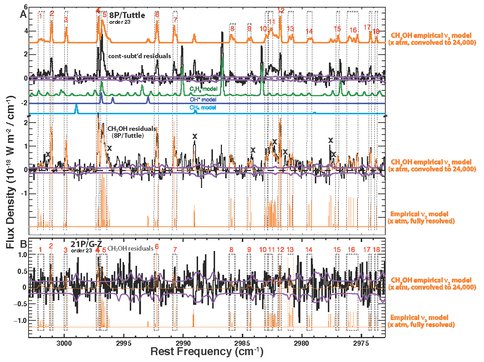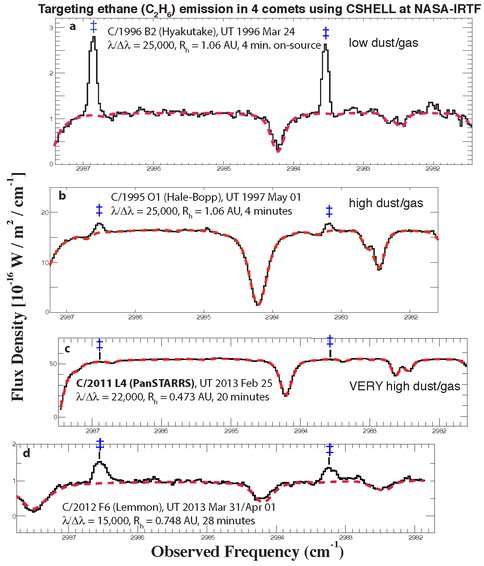2013 Annual Science Report
 NASA Goddard Space Flight Center
Reporting | SEP 2012 – AUG 2013
NASA Goddard Space Flight Center
Reporting | SEP 2012 – AUG 2013
Volatile Composition of Comets: Emphasis on Oxidized Carbon
Project Summary
DiSanti’s research emphasizes the chemistry of volatile oxidized carbon in comets, in particular the efficiency of converting CO to H2CO and CH3OH through reduction reactions on the surfaces of icy grains prior to their incorporation into the cometary nucleus. Additionally, oxidation reactions on grains can play a significant role, particularly for CO-enriched, C2H2-depleted comets such as C/2009 P1 (Garradd; see item 2 under Section 3 below). Such processes produce precursor molecules that (if delivered to Earth through impact of comet nuclei) could have enabled the emergence of life, and so are highly relevant to Astrobiology.
Project Progress
M. DiSanti led two studies that were completed in this reporting period:
(1) A new empirical fluorescence model was developed for the ν2 vibrational band of CH3OH in comets. A paper describing the model and its application to short period comet 21P/Giacobini-Zinner was published in the Astrophysical Journal (DiSanti et al. 2013). A comparison of model and measurement is shown in Figure 1.
(2) We measured the chemical composition of comet C/2009 P1 (Garradd) based on observations with the high-resolution infrared spectrograph (NIRSPEC) on the Keck 2 telescope (DiSanti et al. 2014, Icarus). This paper reported pre- and post-perihelion abundances for several molecules, and (pre-perihelion) quantified the fractions of H2O that were released directly from the nucleus and from a distributed source in the coma (Figure 2). The paper also suggested a means of testing the role of “redox” reactions in forming volatiles on pre-cometary icy grains. Several volatiles detected in comets (e.g., H2CO) are species that play important roles in Astrobiology.
Comets observed in this reporting period, using high-resolution infrared echelle spectrographs:
(1) C/2011 L4 PanSTARRS (IRTF/CSHELL): Two observing runs were awarded, one pre-perihelion (Feb. 26 – 28) and one post-perihelion (Mar. 31, Apr. 1); the latter dates were at the end of 8 consecutive days split between 3 proposals (PI’s Bonev, Villanueva, DiSanti). In February, the comet was found to be extremely dusty. Normally C2H6 is among the strongest organic signatures in comets but it was not detected in L4 PanSTARRS, and we achieved only a tentative detection of H2O (Figure 3). We subsequently switched targets to C/2012 F6 (Lemmon) for the later runs (see item 2 below).
(2) C/2012 F6 Lemmon (IRTF/CSHELL): M. DiSanti led CSHELL observations on 2013 March 31 & April 1/2, and the ensuing analysis of the CSHELL data set (Figure 4). The CSHELL results were included in a refereed publication (Paganini et al. 2014). This paper presents the first study combining cometary spectra obtained with all three existing ground-based high-resolution infrared spectrographs (VLT/CRIRES, IRTF/CSHELL, and Keck/NIRSPEC), and was a collaborative effort between the Goddard and Univ. Hawai’i NAI Teams.
(3) Comet 29P/Schwassmann-Wachmann 1 (Keck/NIRSPEC): One full night of observing time was allocated to the Univ. Hawai’i NAI Team (PI, K. Meech). J. Keane (UH) operated NIRSPEC, and members of the GCA (including M. DiSanti) participated in acquiring spectra of 29P and F6 Lemmon. The F6 results are included in Paganini et al. 2014. The new observations of 29P revealed prominent emissions from CO, and preliminary results were presented at the 2013 Division for Planetary Sciences meeting (Keane et al. 2013). L. Paganini describes the initial detections of multiple lines of CO in 29P and interpretations, in his report (see also Paganini et al. 2013). Work is in progress to characterize opacity effects in the recently observed CO lines. This effort represents an additional example of collaborative work among teams within the NAI.
(4) Comet C/2012 S1 (ISON). The combination of being dynamically new and also a sun-grazing comet led NASA HQ to call for a worldwide observing campaign. M. DiSanti was the sole representative from NASA-Goddard Space Flight Center to serve on the Comet ISON Observing Campaign team, devoted to facilitating communication among observers with the goal of maximizing the overall science returned. M. DiSanti and others within the GCA were instrumental in various aspects of preparation for the campaign, for example writing and submitting observing proposals, and detailed planning of observations. Members of the GCA were awarded time with NIRSPEC/Keck (M. Mumma, PI) and CSHELL/IRTF (B. Bonev and M. DiSanti, PIs), and UH colleagues also won time (J. Keane, PI). Observing occurred in the following reporting period and results will be included in our next report.
Publications
-
DiSanti, M. A., Bonev, B. P., Villanueva, G. L., & Mumma, M. J. (2012). HIGHLY DEPLETED ETHANE AND MILDLY DEPLETED METHANOL IN COMET 21P/GIACOBINI-ZINNER: APPLICATION OF A NEW EMPIRICAL ν 2 -BAND MODEL FOR CH 3 OH NEAR 50 K. The Astrophysical Journal, 763(1), 1. doi:10.1088/0004-637x/763/1/1
-
PROJECT INVESTIGATORS:
-
PROJECT MEMBERS:
Michael DiSanti
Project Investigator
Michael Mumma
Co-Investigator
Boncho Bonev
Collaborator
Erika Gibb
Collaborator
Karen Magee-Sauer
Collaborator
Lucas Paganini
Collaborator
Geronimo Villanueva
Collaborator
-
RELATED OBJECTIVES:
Objective 3.1
Sources of prebiotic materials and catalysts
Objective 3.2
Origins and evolution of functional biomolecules




